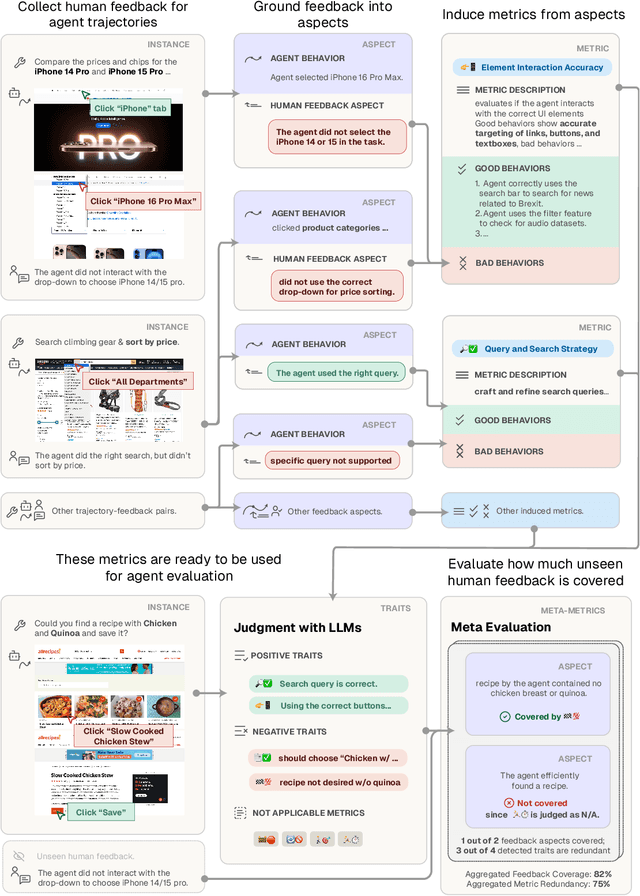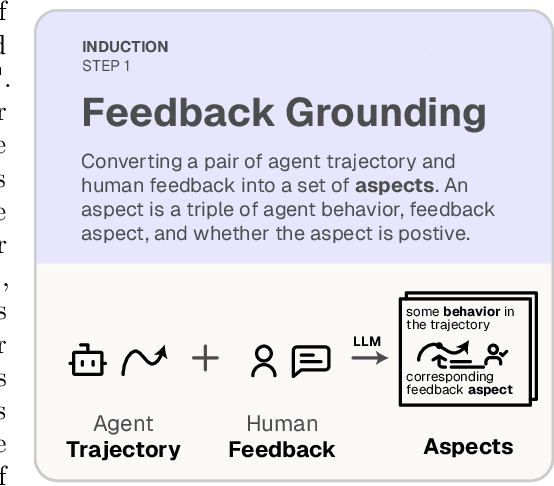Xinkai Yu
AutoLibra: Agent Metric Induction from Open-Ended Feedback
May 05, 2025



Abstract:Agents are predominantly evaluated and optimized via task success metrics, which are coarse, rely on manual design from experts, and fail to reward intermediate emergent behaviors. We propose AutoLibra, a framework for agent evaluation, that transforms open-ended human feedback, e.g., "If you find that the button is disabled, don't click it again", or "This agent has too much autonomy to decide what to do on its own", into metrics for evaluating fine-grained behaviors in agent trajectories. AutoLibra accomplishes this by grounding feedback to an agent's behavior, clustering similar positive and negative behaviors, and creating concrete metrics with clear definitions and concrete examples, which can be used for prompting LLM-as-a-Judge as evaluators. We further propose two meta-metrics to evaluate the alignment of a set of (induced) metrics with open feedback: "coverage" and "redundancy". Through optimizing these meta-metrics, we experimentally demonstrate AutoLibra's ability to induce more concrete agent evaluation metrics than the ones proposed in previous agent evaluation benchmarks and discover new metrics to analyze agents. We also present two applications of AutoLibra in agent improvement: First, we show that AutoLibra-induced metrics serve as better prompt-engineering targets than the task success rate on a wide range of text game tasks, improving agent performance over baseline by a mean of 20%. Second, we show that AutoLibra can iteratively select high-quality fine-tuning data for web navigation agents. Our results suggest that AutoLibra is a powerful task-agnostic tool for evaluating and improving language agents.
DiverseDialogue: A Methodology for Designing Chatbots with Human-Like Diversity
Aug 30, 2024Abstract:Large Language Models (LLMs), which simulate human users, are frequently employed to evaluate chatbots in applications such as tutoring and customer service. Effective evaluation necessitates a high degree of human-like diversity within these simulations. In this paper, we demonstrate that conversations generated by GPT-4o mini, when used as simulated human participants, systematically differ from those between actual humans across multiple linguistic features. These features include topic variation, lexical attributes, and both the average behavior and diversity (variance) of the language used. To address these discrepancies, we propose an approach that automatically generates prompts for user simulations by incorporating features derived from real human interactions, such as age, gender, emotional tone, and the topics discussed. We assess our approach using differential language analysis combined with deep linguistic inquiry. Our method of prompt optimization, tailored to target specific linguistic features, shows significant improvements. Specifically, it enhances the human-likeness of LLM chatbot conversations, increasing their linguistic diversity. On average, we observe a 54 percent reduction in the error of average features between human and LLM-generated conversations. This method of constructing chatbot sets with human-like diversity holds great potential for enhancing the evaluation process of user-facing bots.
Robust TOA-based Localization with Inaccurate Anchors for MANET
Dec 29, 2023Abstract:Accurate node localization is vital for mobile ad hoc networks (MANETs). Current methods like Time of Arrival (TOA) can estimate node positions using imprecise baseplates and achieve the Cram\'er-Rao lower bound (CRLB) accuracy. In multi-hop MANETs, some nodes lack direct links to base anchors, depending on neighbor nodes as dynamic anchors for chain localization. However, the dynamic nature of MANETs challenges TOA's robustness due to the availability and accuracy of base anchors, coupled with ranging errors. To address the issue of cascading positioning error divergence, we first derive the CRLB for any primary node in MANETs as a metric to tackle localization error in cascading scenarios. Second, we propose an advanced two-step TOA method based on CRLB which is able to approximate target node's CRLB with only local neighbor information. Finally, simulation results confirm the robustness of our algorithm, achieving CRLB-level accuracy for small ranging errors and maintaining precision for larger errors compared to existing TOA methods.
 Add to Chrome
Add to Chrome Add to Firefox
Add to Firefox Add to Edge
Add to Edge